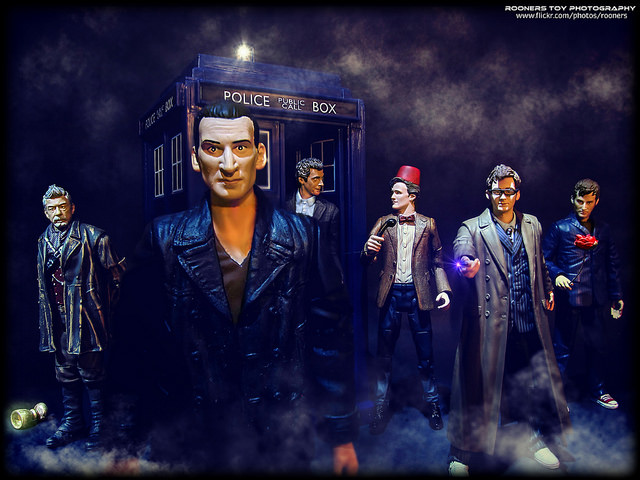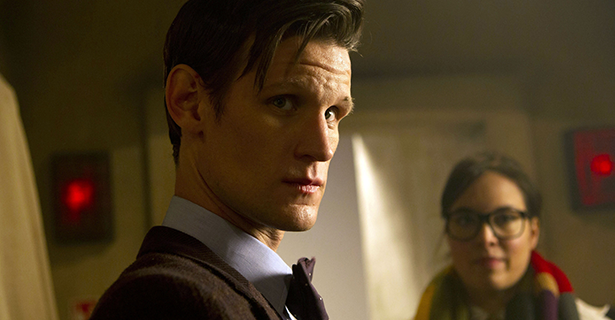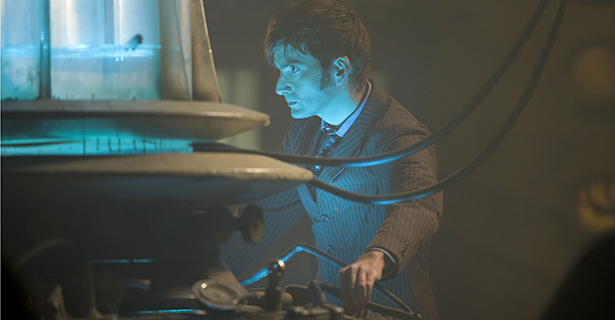Doctor Who in the 21st Century

In the 21st century Doctor Who has played a key role in the BBC’s strategies to assert the continuing value of its public service remit against the fragmentation of television audiences in the multi-channel age. Joseph Oldham explains how this has been accomplished by drawing upon the traditions of public service and national address associated with an age of television from which Doctor Who first emerged.
Doctor Who’s origins in the early 1960s lie in a period when British television was structured as a duopoly, with a public service broadcaster (the BBC) and its single commercial rival (ITV), a situation that remained constant (aside from the addition of a second BBC channel in 1964) until the beginning of the 1980s.
In 1988, Paddy Scannell described how broadcasting, according to this traditional model, ‘brought together for a radically new kind of general public the elements of a culture-in-common (national and transnational) for all’.1 In its original conception, Doctor Who can be seen as a product of this landscape, with the broad family audience associated with its traditional Saturday teatime slot commonly seen as integral to its success. However, its creation can also be seen as part of a drive for the BBC to become more competitive in the face of the ratings success enjoyed by its new rival, ITV. Sydney Newman, the BBC Head of Drama (1962-67) who devised the series’ initial concept, was recruited by the BBC for his experience in commercial television, and Doctor Who itself was, partly, designed to deliver something more modern to the format of the children’s serial. Thus, at its inception, Doctor Who can be seen to have occupied a peculiar ground between the values of public service and a more populist appeal.
By the 1980s however, when Doctor Who’s original run hit a decline in popularity, the longstanding ‘scarcity’ of the broadcasting landscape was being eroded by an increasingly fragmented, multi-channel model. This, in part, resulted from a more commercial conception of television in line with the ‘free market’ philosophy of Margaret Thatcher’s Conservative government. Whilst many commentators have celebrated this shift in terms of ‘choice’ and ‘liberation’ for the viewer, others have bemoaned the declining centrality of public service traditions.
Scannell, for example, warned of the potential fragmentation of the general television public “into particular taste publics whom advertisers are increasingly keen to target. In so doing it destroys the principle of equality of access for all to entertainment, informational and cultural resources in a common public domain”.2 With the license fee remaining as its key source of funding, the biggest challenge faced by the BBC over subsequent years has been finding ways to retain the validity of its public service remit, whilst coming under pressure from the government to maintain a high audience share in the increasingly competitive broadcasting environment.
The beginning of the new millennium saw the arrival of Greg Dyke as director-general of the BBC, instigating what has widely been seen as a new direction for the corporation, and setting the restoration of BBC 1 as a particular priority. Under the new controller, Lorraine Heggessey, BBC 1 developed a more populist and competitive output with particular investment in dramas; notable titles from this era including Clocking Off (BBC 1, 2000-3), Spooks (BBC 1, 2002-11), State of Play (BBC 1, 2003), New Tricks (BBC1, 2003-) and Hustle (BBC1, 2004-12). The shift by BBC 1 to a more populist mode whilst still under licence fee funding proved controversial, although as Georgina Born argues, “if the BBC’s popularity had not been demonstrated, it could have been shunted in to a ‘market failure’ siding, forced to vacate the popular ground and retaining only that minoritarian, ‘cultured’ remit that its antagonists would prefer”.3
Although the initial steps towards reviving Doctor Who can be traced as far back as discussions between the BBC and eventual head writer Russell T. Davies in 1998, its eventual commissioning by Heggessey in late 2003 and production as an expensive, ‘glossy’ flagship series can be seen as part of the broader revitalisation of BBC 1 and renewed commitment to popular drama under Greg Dyke. Yet it is notable that the series was commissioned in the midst of the difficult period of the Hutton Inquiry, which controversially culminated in Dyke’s departure from the BBC in January 2004. More broadly, this led to deterioration in the relationship between the BBC and the Labour government of the time, and placed the BBC in a highly vulnerable position in the run-up to the renewal of its Royal Charter in 2006. The arrival of Michael Grade as BBC chairman in April 2004 was, however, widely interpreted a decisive step forward by BBC, with Michael Grade himself publically declaring he was a ‘Dykeist’. Thus a broad continuation of Greg Dyke’s overall approach, walking the tightrope of public service and populism, was maintained and allowed the new Doctor Who to flourish when it eventually began transmitting in March 2005.

A broader problem faced by the BBC in terms of demonstrating the importance of its public service role is the fragmentation of the British viewing public. As Graeme Turner writes, “demographic trends indicate that it is the over-50s who dominate the remaining broadcasting audience, raising the possibility that the next generation of viewers – the primary consumers of alternatives such as online video – may never acquire that habit”.4 Indeed, it is noticeable that most of the programmes commonly associated with the ‘first wave’ of the BBC 1 renaissance were post-watershed and aimed at predominantly adult audience. In these contexts, the decision to return to an old popular drama famous for its multi-generational address is highly significant. It is evident from the earliest coverage of the revival in the trade publication Broadcast that restoring it to the iconic Saturday night slot it had occupied across the 1960s and 1970s was an integral part of the commission, this identified as “a time that has recently consistently underplayed in the ratings”.5
Following its return, the consistent ratings success enjoyed by the series has been commonly attributed to its broad audience appeal to both adults and children, thereby recapturing the family audience it enjoyed back at its peaks of popularity in earlier decades; a feat which is arguably a much more impressive achievement in the fragmented multi-channel environment.
Such broadcasting strategies can, in a sense, be seen as a responding to the phenomenon of the multi-channel age that John Ellis terms ‘choice fatigue’, “the feeling that choices are simply too difficult; a nostalgia for pattern, habit and era when choices seemed few”.6 Doctor Who’s role in the broadcasting landscape of the twenty-first century is therefore to function, substantially, along nostalgic lines, reviving the Saturday night family entertainment schedules of earlier decades and thereby working to restore the associated multi-generational ‘culture-in-common’. Several commentators have remarked upon the value of this success in 2005 towards the renewal of the BBC’s Charter the following year, and thus the series can be seen to have helped address two of the BBC’s problems: finding a means of addressing a younger generation of viewers and, in doing so, helping to validate the BBC’s continued existence according to the licence fee-funded model.7 Thus, as in the case of its original debut in 1963, Doctor Who has and continues to play a pivotal role in helping the BBC redefine itself for a new television era.

Indeed, as one of the remaining key sites of television’s national address, the broader Saturday night schedule been invested with a sense of nostalgia and tradition. Concurrently with Doctor Who’s revival, a nostalgic impulse can be found in numerous competitive talent shows also broadcast on a Saturday night, such as Strictly Come Dancing (BBC 1, 2004-), a revival of the original Come Dancing (BBC 1, 1949-98), and the lineage of talent scouting series oriented around longstanding ‘classic’ musicals, beginning with How Do You Solve a Problem Like Maria? (BBC 1, 2006). Positioning the revived Doctor Who alongside other such ‘retro shows’, Broadcast’s Philip Reevell commented that “it makes you realise that BBC1’s real strength is as a legacy channel - where today's output draws on the collective memory of the older set to net younger viewers”.8
The BBC’s keen understanding of this legacy is illustrated by subsequent attempts to recapture the success of Doctor Who with similar Saturday teatime drama series. Whilst ITV 1 launched rivals such as The Eleventh Hour (ITV 1, 2006) and Primeval (ITV 1, 2007-11) in response to Doctor Who on the more superficial level of a science fiction concept, by contrast two subsequent BBC 1 series designed to occupy this slot, Robin Hood (BBC 1, 2006-09) and Merlin (BBC 1, 2008-12) have instead focused upon iconic figures of British folklore. This is revealing in its implicit suggestion that, having now remained popular over multiple decades and generations, Doctor Who can be considered a modern-day British myth that occupies the same plinth.9
Whilst this article has primarily focused upon the role played by the series in the broadcasting landscape upon its initial return in 2005, I will conclude with some comparative comments concerning the anniversary special, ‘The Day of the Doctor’ (2013). A special out-of-series episode such as this was in a similar vein to the Christmas specials that have been a key part of the series’ annual broadcasting pattern since 2005; yet here the occasion was generated by the series’ own history, further indicating the central role that it now enjoys in the broadcasting landscape.10
As usual with these specials, ‘The Day of the Doctor’ was broadcast in the Saturday evening slot (fortuitously coinciding with the anniversary date) with the family audience as its primary, British, target. Yet the special was also broadcast (‘simulcast’) in several countries at once, the culmination of an overseas marketing strategy which has become increasingly coordinated, and shown concurrently in cinemas around the world. This strategy was apparently at least partially motivated to stem leaks, thus responding to the increasingly globalised culture surrounding television. However, it is interesting to observe the ideal of Doctor Who bringing disparate groups of viewers together. This was traditionally rooted in national and public service conceptions of broadcasting, but has now expanded beyond the UK and even the medium of television itself.
References
- Paddy Scannell, ‘Radio Times: The Temporal Arrangements of Broadcasting in the Modern World’, in Phillip Drummond and Richard Paterson (eds), Television and its Audience: International Research Perspectives (London: BFI, 1988), p. 29.
- Paddy, Scannell, ‘Public service broadcasting and modern public life’, in Media, Culture and Society, 11:2 (April 1989), p. 139.
- Georgina Born, Uncertain Visions: Birt, Dyke and the Reinvention of the BBC (London: Vintage, 2005), p. 473.
- Graeme Turner, ‘Television and the Nation: Does this matter anymore?’; in Graeme Turner and Jinna Tay (eds), Television Studies After TV: Understanding Television in the Post-Broadcast Era (London: Routledge, 2009), p. 55.
- Luke Satchell, ‘Dr Who to return to BBC’, Broadcast (20 September 2003).
- John Ellis, Seeing Things: Television in the Age of Uncertainty (London: I.B. Tauris, 2000), p. 171.
- Philip Reevell, ‘Ratings – Are family audiences the new holy grail of ratings?’, Broadcast (3 June 2005); and David Butler, ‘Introduction’; in David Butler (ed.), Time and Relative Dissertations in Space: Critical Perspectives on Doctor Who (Manchester; New York: Manchester University Press, 2007), p. 11.
- Philip Reevell, ‘Reevell’s Ratings - Why BBC1’s legacy formula is its real strength’, Broadcast (6 July 2007).
- In fact, over the decade preceding Doctor Who’s revival, the BBC made several other attempts to create action-adventure drama for family audiences in the same timeslot, including the technological spy thriller Bugs (BBC 1, 1995-99), promoted as the ‘Avengers of the 90s’, and a remake of Randall and Hopkirk (Deceased) (BBC 1, 2000-01). Retrospectively somewhat obscured by the success of Doctor Who, these similarly looked back to older television traditions, specifically the famous ‘adventure series’ of the 1960s.
- A comparable precedent is the feature-length twentieth anniversary special ‘The Five Doctors’ (1983).
Published
November 2013
Author
Joseph Oldham is an Associate Fellow in the Department of Film and Television Studies, leading seminars on "The Hollywood Cinema" and "Basic Issues & Methods: Film Criticism". His PhD thesis, 'Serial Narratives of the Secret State in British Television Drama', is a study of the history of the spy and conspiracy genres on British television. His research interests include British television history, British cultural history, spy and clandestine fiction, and paranoid aesthetics and narratives.
Images
BBC/Adrian Rogers
BBC/Adrian Rogers
A Trip of a Life Time by Rooners Toy Photography (CC BY-NC-ND 2.0)
Terms for republishing
The text in this article is licensed under a Creative Commons Attribution 4.0 International License (CC BY 4.0).
Share

